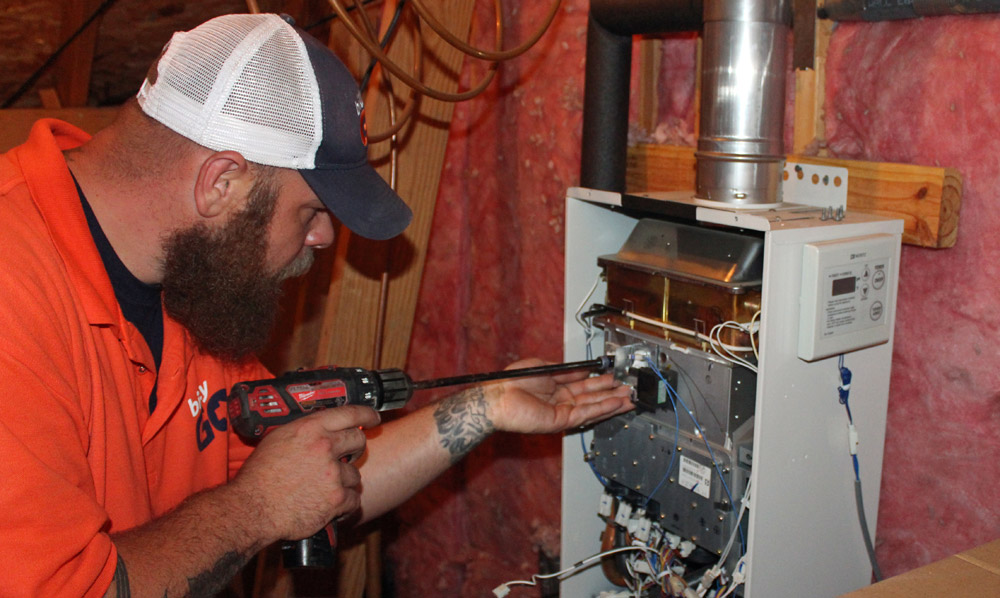We’re betting water heater maintenance isn’t at the top of your to-do list today. We understand, but keep in mind that water heaters are sneaky.
They know when you have house guests, when you plan to do laundry and when you’re ready for a hot shower. That’s when they deliver ice water on cue.
Most of us take hot water heaters for granted until they stop working. Then, instead of a problem, we have an emergency because hot water is such a big part of our daily routines. Water heaters account for about 20% – 25% of a home’s total monthly utility bills.
Problems to Expect from Your Hot Water Heater
Rust. Sediment. You can’t anticipate all the problems your hot water heater might develop, but you can count on rust and sediment – the two biggest water heater killers – to be in the picture sooner or later. There some simple things you can do to combat them so you can have fewer surprises, save money on utility bills and get more years of service for your investment.
The life expectancy of storage-tank gas and electric heaters is about 8 – 12 years. Tankless water heaters may last 20 years or longer. Regular water heater maintenance helps get better performance and more years of service from water heaters of all types.
However, performance and longevity are not the most important considerations. Poorly maintained hot water heaters pose a serious safety risk in your home. The combination of fuel, heat, water, and pressure building up in a confined space make for a potentially volatile mix that must be controlled.
Safety issues usually take a long time to develop, which make them easy to miss or ignore. Most of the problems present themselves first as an inconvenience that “all of a sudden” becomes dangerous, including:
- Rusting tank
- Anode rod depletion
- Sediment buildup
- High water pressure
- Corrosive fumes
- Wrong size heater
Water Heater Temperature and Pressure
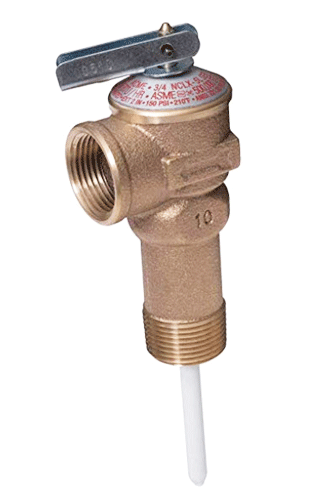 Any of those issues can lead to equipment failure over time, but there are notable – and important – exceptions to that list that pose real dangers. Hot water heaters sometimes have mechanical failures due to defective parts or unusually harsh water conditions that accelerate corrosion and limescale buildup.
Any of those issues can lead to equipment failure over time, but there are notable – and important – exceptions to that list that pose real dangers. Hot water heaters sometimes have mechanical failures due to defective parts or unusually harsh water conditions that accelerate corrosion and limescale buildup.
The temperature and pressure relief valve (TPR valve) is vulnerable and should be checked at least once each year. You’ll find it on the top or side of the tank. It is easily identified by the lever device on it.
Heating water in a tank increases the pressure inside it. The TPR valve’s job is to vent off excess pressure, usually caused by excessive heat buildup. Most TPR valves for residential models are designed to open when water temperature exceeds 210 degrees Fahrenheit or water pressure is greater than 150 PSI. When the valve opens it discharges hot water through the overflow tube connected to it.
If the valve fails or sticks – which can happen without proper water heater maintenance – pressure in the water heater tank can build to explosive levels. This video shows pressure buildup in a hot water heater that turned it into a water rocket launched straight through the roof. This can happen when a TPR valve fails, which is why we recommend replacing them every three years.
Water Heaters Are a Leading Cause of Homeowner Insurance Claims
Most hot water heater failures aren’t as spectacular or noisy as a big explosion. They’re sneaky. Some problems, such as water leaks, develop so gradually you won’t likely notice unless you’re looking for them – or until water starts dripping from the ceiling or pooling on the floor.
Water damage from water heater tank leaks and failures of valves and supply lines are the third most common water damage homeowner insurance claims. Only weather-related flooding and overall faulty plumbing cause more claims. Taken together, those claims average $6,965 each.
Water leaks usually don’t get detected right away. By the time you become aware of one, hundreds of gallons of water may have migrated from your hot water heater in the attic to floors below (garage locations fare somewhat better). To add insult to injury, a leaking tank or fitting can cause massive water damage that may not be covered by homeowners’ insurance. Clearly, preventive water heater maintenance is worth the effort.
Water Heater Maintenance Varies with Heater Type
Hot water heaters work in different ways, so they have different service requirements. Some burn natural gas or propane or use electricity to heat water. Condensing water heaters borrow hot exhaust gasses, while heat pump/hybrid water heaters pull heat from the air.
Geothermal systems transfer heat from groundwater to hot water storage tanks. Hydronic heating systems common in the Northeastern United States (and in Canada and Europe, as well) have a boiler that heats water and a plumbing system that circulates it throughout a home to provide radiant heat and diverts some to hot water taps.
This article addresses the types most commonly in use in the US – electric and gas water heaters with tanks and tankless water heaters.
Maintenance for Water Heaters with Tanks
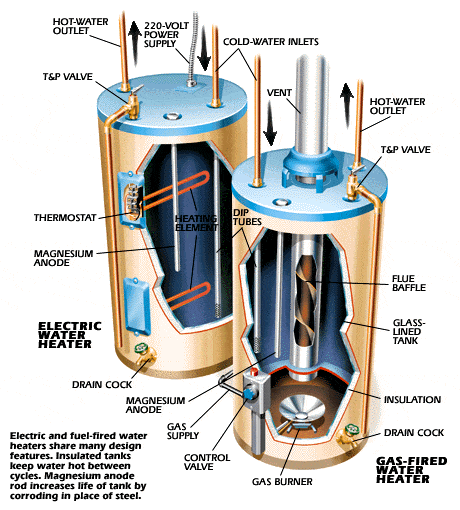 The two most common hot water heaters in the United States are gas and electric tank-type heaters, shown in the cutaway view in this Popular Mechanics illustration. The accompanying article serves as a good primer or refresher on how water heaters work.
The two most common hot water heaters in the United States are gas and electric tank-type heaters, shown in the cutaway view in this Popular Mechanics illustration. The accompanying article serves as a good primer or refresher on how water heaters work.
Two plagues that will be visited on any storage-tank water heater are internal rust and mineral sediment buildup. Failure to keep these two in check with regular water heater maintenance will result in eventual failure of the tank.
Rust in Tank
With the exception of tankless heaters, all water heaters have insulated storage tanks that keep a supply of hot water available for instant use. Copper used to be used, but since the middle of the last century, most tanks have been made of glass-lined steel. Now, thermoplastic tanks are providing alternatives that are durable and energy-saving.
Copper had some inherent disadvantages: it loses heat fast and corrodes easily; glass-lined steel resists corrosion better. But, without the glass lining (a thin coating similar to a ceramic glaze on pottery), steel tanks would rust out quickly. The glass also provides some increased heat retention.
Constant heating and cooling cause the tank to expand and contract, which can weaken or crack the glass lining. Also, some tanks simply are built better than others. Regardless of the cause, there always is some metal exposed to the water that allows corrosion to happen.
To counter this, manufacturers include a sacrificial anode rod, made of magnesium, aluminum or zinc, in the tank. The idea is to have the rod corrode, or sacrifice itself, so the tank won’t. It’s based on galvanic corrosion (also called bimetallic corrosion), in which one metal corrodes instead of another when in an electrolyte, such as water. The image below shows a new anode rod beside a corroded and spent one.
Anode rods are made to be consumed and replaced, at least every 3 – 4 years as part of routine water heater maintenance. They may need to be replaced more often, depending on the quality of your tank, water hardness, how much hot water you use and what the rods are made of. If you don’t check on them annually and replace them when they’re corroded, you’re not only asking for trouble, you’re certain to get it. The tank will rust and fail.
Electric hot water heaters are especially prone to corrosion because the heating elements, made of copper-sheathed steel, are immersed in water in the tank. Heating elements must be inspected and replaced as needed.
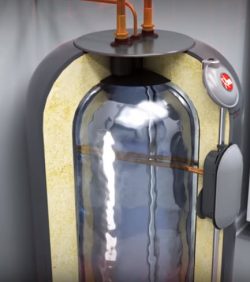 Stainless steel tanks offer an alternative because of their anti-corrosive properties. No anode rod is necessary. However, stainless steel’s higher material and fabrication costs have kept it from catching on in the competitive United States market, except in condensing water heaters. It is popular in Canada and Europe, where it is mostly used in solar and hydronic systems.
Stainless steel tanks offer an alternative because of their anti-corrosive properties. No anode rod is necessary. However, stainless steel’s higher material and fabrication costs have kept it from catching on in the competitive United States market, except in condensing water heaters. It is popular in Canada and Europe, where it is mostly used in solar and hydronic systems.
The Rheem® Marathon® electric water heater tank (right) is plastic, which negates the issue of rusting altogether. The tank itself is a seamless blow-molded plastic (think hollow plastic Christmas lawn ornaments), seamless tank with heavy foam insulation to give it an impressive ability to keep water hot.
The outer shell is made of multiple layers of filament-wound fiberglass. The Marathon operates up to 50% more efficiently than traditional electric water heaters, thanks to its thick layer of insulation. The tank also has a lifetime warranty.
Sediment Buildup
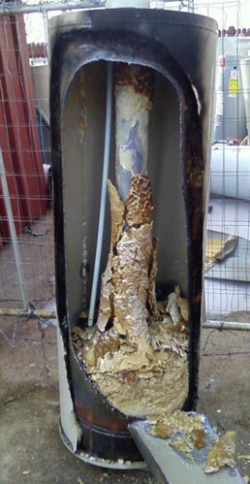 When water is heated mineral deposits in the water separate and settles to the bottom of the tank. The harder the water, the faster the sediment builds up. Sediment must be cleaned out at least once each year to ensure good operational performance and prolong the heater’s useful life. Any investment you make in water heater maintenance will pay dividends because of this process alone.
When water is heated mineral deposits in the water separate and settles to the bottom of the tank. The harder the water, the faster the sediment builds up. Sediment must be cleaned out at least once each year to ensure good operational performance and prolong the heater’s useful life. Any investment you make in water heater maintenance will pay dividends because of this process alone.
This image shows extreme sediment buildup in a gas water heater. The sediment piled high on the bottom of the tank and formed a heavy, crusty layer on the flue. Sediment at the top of the flue was shaken off when the tank was transported.
The sediment buildup acts as an insulation barrier that keeps heat from the water. That means heat must be applied longer to get the water up to the selected temperature, driving up utility bills.
Longer heating cycles also overheat the tank bottom, weakens the steel and damages the glass lining, paving the way to a catastrophic failure than can dump 30 – 50 gallons of water or more in your home. The sediment also can clog the drain valve or migrate into valves in a recirculating hot water system, jamming them open and causing the circulation pump to burn out.
Had the heater shown been an electric water heater, the bottom heating element would have been covered, causing it to burn out.
Water Pressure, Corrosive Fumes, and Heater Size
By code, most municipalities require a minimum water pressure of 20 – 30 pounds per square inch, but water pressure of 45 – 60 PSI is the norm. It should be no higher than 80 PSI. Low water pressure is an inconvenience, but the high water pressure and water pressure spikes put added stress on pipes, joints and water heaters, causing things to wear out faster.
Corrosive fumes from common household cleaners such as bleach and ammonia can corrode water heater tanks, as well. Store and use them far enough away from gas water heaters that fumes cannot contaminate the air used for combustion.
Water heater size has a direct impact on operating cost. A water heater that’s bigger than you need wastes energy when the water cools off and gets reheated before you can use it. This happens as often as 8-12 times per day. On the other hand, a water heater that’s too small will work more than it should, trying to keep up. As a result, it will wear out faster.
Tankless Water Heater Maintenance
Tankless water heaters heat and deliver hot water on demand. Since no water is stored requiring constant reheating, tankless heaters are more efficient than water heaters with tanks.
That eliminates the problems of rust and sediment buildup, but there’s no free lunch. Instead of sediment settling in a tank, minerals in the water form a mineral scale buildup in tankless water heaters.
As this image shows, scale buildup in heat exchanger tubing is just as much a problem as sediment buildup in a tank and can have equally bad results – lower efficiency, colder water, and shortened equipment life. Routine maintenance is a must.
Tankless water heaters should be flushed annually to combat scale buildup. This is especially important if you have hard water or have the heater thermostat set higher than 120 degrees. Some do-it-yourselfers like to descale tankless heaters themselves, but most people prefer to leave it in the hands of a licensed plumber, whose trained eyes look for other potential problems during that procedure.
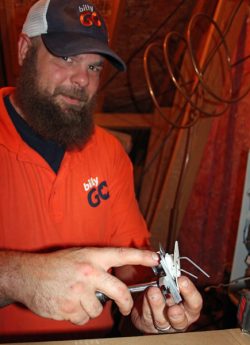 All tankless water heaters, including gas heaters, require electricity to work. They have PC boards, digital displays, and ignitors that run on electricity, all of which need to be maintained well.
All tankless water heaters, including gas heaters, require electricity to work. They have PC boards, digital displays, and ignitors that run on electricity, all of which need to be maintained well.
One of the most common repairs on gas tankless water heaters is the ignition system, which includes the ignitor coil and metal rods that carry the spark to the gas. The plumber shown here is preparing to install a new ignition plug in a gas tankless heater.
Other components to check include the gas valve, burner, combustion chamber, combustion fan, heating elements (electric heaters), temperature sensors, manifolds, and venting. Some tankless heaters have pressure relief valves, too.
A competent DIYer can flush a tankless heater safely but should not attempt more thorough maintenance with training. Tankless water heaters are sophisticated equipment that requires professional maintenance from water heater repair specialists to assure efficient and safe operation.
Other Water Heater Maintenance Essentials
Plumbers see things during water heater maintenance service calls that most people without their training and experience will miss. Here are some of the most important ones.
- Gas lines security – gas lines must be placed where they cannot be inadvertently damaged. Gas line inspections should be performed regularly.
- Exhaust venting – proper venting of exhaust gasses keeps them from poisoning the air inside your home. A 4-inch exhaust vent is required for water heaters of 50 gallons or larger.
- Water heater clearance – a clearance of 12 inches on all sides is recommended to allow for proper airflow and combustion.
- Temperature setting – the recommended temperature to prevent hot water burns and prolong equipment life is 120 degrees F. Some conditions, such as the location of the water heater and distance hot water must travel, may call for a slightly higher setting.
- Drain pan and drain line – the pan should be free of insulation and other debris and the drain line must be clear. Plumbers check lines with air pressure tests.
- Expansion tank – some local plumbing codes, which licensed plumbers are required to know, require expansion tanks to contain overflow water when pressure builds up in a tank.
- Pipe insulation – water lines in attics and other places subject to freezing temperatures should be insulated to prevent freezing.
CONCLUSION
Regular water heater maintenance will forestall the day when you need to think about replacing a water heater. With regular maintenance, you should be able to get a few more years than the 8 – 12-year warranty periods of most residential hot water heaters.
The most important things you can do are: (1) flush sediment from the tank regularly to prevent sediment buildup and, (2) inspect the sacrificial anode rod that keeps the tank from corroding and rusting out. Tankless water heaters should be descaled annually or as often as needed for local water conditions.
You also will save money and get optimal performance by keeping your water heater free of sediment, scale buildup, and rust. More importantly, regular water heater maintenance will guard against catastrophic failure that can result in personal injury and tens of thousands of dollars in property damage.
Know your limitations: for best results get a licensed plumber to perform regular water heater maintenance.

